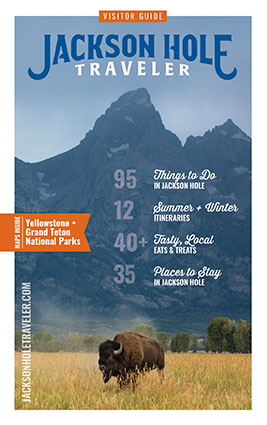Having spent more than 30 years skiing at the Jackson Hole Mountain Resort, you hone in on what to wear skiing and snowboarding in this environment. It always starts with checking the weather forecast for both the temperatures and wind speeds at the base, mid-mountain and the summit. I use Mountain Weather, the Bridger-Teton Avalanche Forecasting Report and the JH Insider's App from the Jackson Hole Mountain Resort to see how to dress.
The key is simply layering—but take that a step further and make sure all your layers have a way to vent your body heat. For your upper layers, that would be zippers that extend down your chest and jackets with pit zips. For your bottom layers, zippers that allow your thighs to breath.
The goal is to avoid sweating, from being able to dump your body heat and eliminating constriction points so your blood can flow freely. Wear only one pair of lighter ski socks—your boots have plenty of insulation—and don't use those glove liners; they reduce your blood flow. Keep your core warm and your extremities will be happy.
The photo above shows the items I like and use. They're all time-tested and made by our Jackson Hole hometown brand, Stio.
Upper Layers
Base Layer - You want a thin lightweight base layer that acts to wick moisture away and zips down to your chest.
Medium Weight Layer - Over your base choose a heavier weight layer for insulation. Make sure it has a chest pocket for your phone so you can keep it warm and working. I almost always wear these first two layers at any temperature.
Insulation Layer - This is the one item I adjust based on both temperatures and wind speed. If it's 20 degrees and below I go for a medium weight down layer. It compresses and moves well under my shell without too much bulk. On warmer days, I might go to a vest or synthetic layer or a really lightweight down layer.
Outer Shell - I am particular about my shell as it needs pit zips and interior storage pockets. (See my article on What's in Your Ski Jacket?) The shell needs to shed snow and water, stop wind and be breathable. I like it without the hood as they just tend to gather snow. On blustery days you could zip that back on, but make sure it fits over your ski helmet. A powder skirt is vital as it traps heat and keeps the fluffy stuff out. Lastly, zip it all the way up and make sure it feels good against your chin and has a high collar to keep the wind out.
Bottom Layers
Underwear - Don't put on those cotton undies. You'll get clammy. Instead, go for a synthetic or wool option that wicks moisture away. This is a key upgrade to your program, so don't skimp.
Ski Tights - I will vary the weight of these tights or longjohns based on temperatures and wind speeds. One thing to watch for is the stitching on the cuff. You can end up with a sore shin from it pressing up against your ski boot. Don't let these items bunch up.
Ski Pants - Without a doubt, the bibs work best to keep the snow out of your bum. Also, you don't have to wear a belt to keep them up which allows you to move more freely and trap more heat around your core. As you heat up use the side zips to vent.
Gear
Ski Gloves - You cannot live in a ski town without multiple pairs and weights. My go-to gloves have cuffs that make them easy to get on and off, keep the snow out and don't have large constriction points around my wrist. I like ones (Black Diamond Guide Gloves) that have removable liners so they can dry separately of the shell.
Ski Socks - More insulation is not better in this case. When your ski boots are properly adjusted around your feet (not overtightened) they have plenty of insulation. You just need a lightweight sock. If you suffer from cold feet try the Lenz sock heaters. The bonus with over-boot heaters is that you can use them in all your outdoor shoes or lounge around the living room in them. They are controlled by an app so you can dial the heat up or down accordingly.
Neck Gaiter - A critical piece for trapping heat and preventing frostbite. I always have it in my pocket to use as needed.
Latham Jenkins, the publisher of Jackson Hole Traveler, loves to ski and is always thinking too much about the form, fit and function of his gear.
Follow Us on Instagram
For more area, event and business information, plus gorgeous photos of Jackson Hole, follow Jackson Hole Traveler on Instagram: instagram.com/jacksonholetraveler/

